| Release List | Reviews | Price Search | Shop | Newsletter | Forum | DVD Giveaways | Blu-Ray/ HD DVD | Advertise |
| Reviews & Columns |
|
Reviews DVD TV on DVD Blu-ray International DVDs Theatrical Reviews by Studio Video Games Features Collector Series DVDs Easter Egg Database Interviews DVD Talk TV DVD Talk Radio Feature Articles Columns Anime Talk DVD Savant HD Talk Horror DVDs Silent DVD
|
DVD Talk Forum |
|
|
| Resources |
|
DVD Price Search Customer Service #'s RCE Info Links |
|
Columns
|
 |
James Stewart -- The Signature Collection |
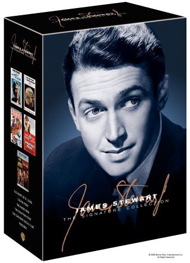
Warner DVD The Stratton Story, The Naked Spur, The Spirit of St. Louis, The FBI Story, Firecreek, The Cheyenne Social Club starring James Stewart Street Date August 15, 2006 49.98 the boxed set Available separately at 19.98 Reviewed by Glenn Erickson |
The much-honored and beloved James Stewart had a good career after his studio days were finished, surpassing most of his work for MGM with such time-honored pictures as It's a Wonderful Life, Winchester '73 and Rear Window. He was the first of the big stars to negotiate profitable percentage deals for his services and own a chunk of the films in which he starred.
James Stewart -- The Signature Collection rounds up six interesting Stewart pictures for MGM and Warner Bros. from 1949 to 1970. It's an odd stack of films, with only one title (The FBI Story) already out on DVD. Five are dramas or genre pieces, with one genre comedy. None are considered bona fide masterpieces, but the mix includes two fine pictures by Billy Wilder and Anthony Mann.
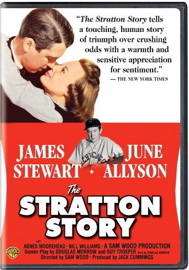
The Stratton Story
1949 / 106 min. / 1:37 flat full frame (correct) / available separately at 19.98
Starring James Stewart, June Allyson, Frank Morgan, Agnes Moorehead
Cinematography Harold Rosson
Art Direction Cedric Gibbons, Paul Groesse
Film Editor Ben Lewis
Original Music Adolph Deutsch
Written by Douglas Morrow, Guy Trosper
Produced by Jack Cummings
Directed by Sam Wood
The Stratton Story always confuses me -- is this the one where Jimmy invents a gun, or the one where he accidentally blows his leg off with one? The second choice is the correct one, as the story of Monty Stratton is the original 'motivational' story for the sports locker room. Monty really did himself in with that rabbit gun, but his love for the game was such that he had to fight his way back to the pitcher's mound! The fact is that The Stratton Story is both moving and unpretentious.
In the late 1940s everybody was looking for a baseball story with a twist, and The Stratton Story is one of the better ones. At least it isn't the Torpedo Patrol Boat story converted to a Girl's Softball Team for Betty Hutton -- a concept pitched by William Holden in Sunset Blvd..
The Stratton Story must have seemed a natural, a Pride of the Yankees-lite about another unfortunate big league ball player whose story caught the public imagination. Sam Wood, the director of the Gary Cooper mega-hit brought many of the same qualities to a sentimental baseball story that couldn't fail.
The film is truer to the spirit of the story than it is the strict facts. Stratton was knocked out of the game by his accident in 1938 and had to settle for being a coach and a batting practice pitcher; his team never abandoned him. When he tried to pitch again in 1946 it was for the minor league, and his record was spotty for the same reason explained in the movie -- opposing coaches directed batters to bunt against Stratton, knowing he'd have a tough time responding.
Interestingly, The Stratton Story never shows Monty's wooden leg, presumably because doing so would be considered in poor taste. This was a time when tens of thousands of young veterans were coping with similar injuries, which shows just how out of touch the Production Code was. And it goes without saying that the word "pregnant" is never used in connection with Ethel's having a baby.
The script plays up the romance between Monty and Ethel. The use of June Allyson as the perfect, suffering marriage partner insured her a decade's worth of similar roles, at least twice more with Stewart. Stewart pulls his same "George Bailey" cutesy acting tricks, all of which work charmingly. It's only twenty years later when he was still mining the same coy looks and confused doubletakes that his act began to get old. The film also takes a reverent attitude with the institution of baseball. All the players behave like well-mannered church boys; noted players Gene Bearden, Bill Dickey and Jimmie Dykes are featured.
Agnes Moorehead and Frank Morgan play familiar types but Wood's film has compensating charms. Most welcome is the fact that Stratton's Texas folksiness isn't played for easy laughs. He's not a hick, nor some kind of Dogpatch hillbilly alien creature like Gary Cooper's "Golly Ma" Sergeant York. Also, Stratton's tragedy is never mined for cheap inspirational hokum, as we now see in the countless video bios of Olympic athletes. If those things are to be believed, acceptance on the American Olympic team is dependent on having a heart-wrenching personal story about overcoming tremendous odds on the road to victory.
Warners' DVD of The Stratton Story is a fine flat transfer of this handsome and unpretentious B&W production. For extras we're given an okay Pete Smith comedy and a hilarious (and violent) Tex Avery cartoon, Batty Baseball. A trailer is included that stresses the emotional nature of the film, with June Allyson talking confidentially to the theater audience.
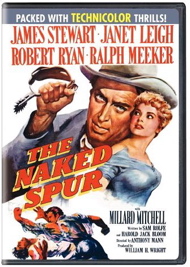
The Naked Spur
1953 / 91 min. / 1:37 flat full frame (correct) /also available separately at 19.98
Starring James Stewart, Janet Leigh, Robert Ryan, Ralph Meeker, Millard Mitchell
Cinematography William Mellor
Art Direction Malcolm Brown, Cedric Gibbons
Film Editor George White
Original Music Bronislau Kaper
Written by Sam Rolfe, Harold Jack Bloom
Produced by William H. Wright
Directed by Anthony Mann
The Naked Spur is one of the highlights of the Anthony Mann-James Stewart teaming of the early 1950s, a tightly scripted and beautifully shot psychological western filmed almost entirely in beautiful outdoor settings. Sam Rolfe and Harold Jack Bloom's economical script gives Mann plenty of opportunity to exercise his violent streak, with the very landscape becoming a treacherous character. Likewise, Stewart's role as a manic bounty hunter puts him always at the edge of a potential nervous breakdown. Like the spur that is jabbed into Robert Ryan's face, the rocks and rapids seem to echo the frayed nerves of Stewart's tormented hero.
Anthony Mann's westerns are morally heavy and stylistically exciting, and The Naked Spur is one of his best, less cornball than his Universal "good vs bad apple" movies (Bend of the River, The Far Country) and a bit less pretentious than his Shakesperian-themed later work, like The Man from Laramie. Much like a Boetticher-Scott story, it takes place entirely in the wild, away from towns; the characters are 'stripped naked' by the violent events to reveal their true natures.
The script isn't thoroughly original, as Millard Mitchell's prospector is right off the stock character shelf, and excellent actors Ralph Meeker and Robert Ryan play baddies of one and two dimensions, respectively. Meeker's rotten soldier is a simple creep with an Indian chief after him for raping one of their women; he forces Kemp's band to help him ambush the whole tribe. As is typical for a 50s western, the moral complexity of the situation is erased in a simple massacre of Red Men. We're more concerned with Howie Kemp's reversion to savagery than we are the obliteration of the innocent Indians.
Robert Ryan is likewise not utilized to his full potential, as the script reveals little depth below his sneering bluff. He starts off great, with one of his best lines ever (para): "Ain't it the way? You get set to face trouble head-on and it sneaks up behind ya every time!" Unfortunately, Ryan's later tricks to turn his captors against one another are so transparent that we wonder how he can fool even the dimwitted Jesse.
Mann compensates for the imperfect script with a masterful visual sense, jamming the Technicolor camera up into the rocks (more 'naked spurs') and shoving the violence in our faces: Painful rope burns, a rockslide filmed looking up past the frightened Stewart, a cave-in, the Indian attack and an impressive conclusion in the midst of some roaring mountain rapids. William Mellor's Technicolor camera soaks up the beautiful but dangerous scenery, giving the film a psychotic landscape -- all of this violence and torment plays out in a forested wonderland.
Stewart is burned, shot, and almost buried alive; and his suffering results in Janet Leigh transferring her concern and affections to him, especially when Ryan's Ben Vandergroat shows how ruthless he's willing to be. Detractors of Stewart point to the fact that he uses the same limited neurotic tricks when playing disturbed characters, but his final dramatic scenes are still effective and touching. He has a choice of becoming a heartless bounty hunter or rejoining the living and going on with Janet Leigh to a possible better future. A dead body means money to replace what was stolen from him and he shows his bitterness when he rejects his dark plans. Perhaps this is small potatoes in the spectrum of great acting, but in western films the scene is quite a revelation.
Warners' DVD of The Naked Spur is a good flat transfer that makes do with a composite element. The color is good but the look is slightly soft, as are many Technicolor movies transferred without benefit of unrealistically expensive 3-strip restoration. Perhaps someday rejuvenating Tech films from original elements won't be so pricey. The movie still looks very good. Extras include a punchy, corny trailer (that apparently brought out the crowds), a lame Pete Smith Specialty short subject and the Tex Avery cartoon Little Johnny Jet, which would have seemed a much better fit for The Spirit of St. Louis. Or am I missing some special connection?
With this release all of the Mann-Stewart westerns are now on DVD, and most of the classic Mann 50s westerns save for his masterpiece Man of the West with Gary Cooper. Savant has once again heard rumors that a Budd Boetticher/Randolph Scott box of Ranown westerns is coming from Sony/Columbia; here's hoping.
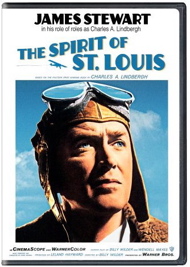
The Spirit of St. Louis
1957 / 2:35 anamorphic enhanced /135 min. / available separately at 19.98
Starring James Stewart, Murray Hamilton, Patricia Smith, Bartlett Robinson, Marc Connelly, Arthur Space
Cinematography Robert Burks, J. Peverell Marley
Art Direction Art Loel
Film Editor Arthur P. Schmidt
Montage Charles Eames
Original Music Franz Waxman
Written by Charles Lederer, Wendell Mayes, Billy Wilder from the book byCharles A. Lindbergh
Produced by Leland Hayward
Directed by Billy Wilder
The Spirit of St. Louis is a major departure for Billy Wilder and not listed among his successes. That's unfortunate because it's a picture with unique qualities, not the least of which is a convincing period atmosphere and a true sense of the spirit of aviation. Biographers tell us that Wilder, along with Douglas Sirk, was a fan of flying and his original intent was to enlarge the autobiography of the politically questionable Charles Lindbergh into a salute to the history of manned flight. The movie seems to have been cursed from the start. It's rumored that James Dean was slated to play Lindbergh and when he was killed the aviator (who had veto rights over all aspects of the production) opted for the 50 year-old James Stewart. Lindbergh 'killed' all of Wilder's embellishments to the bare narrative after they were scripted, approved, and filmed, leaving the film with a weak structure and a dud of an ending.
The Spirit of St. Louis is about as close to 'inspirational' as Billy Wilder ever came, and yet it's filled with his personal themes. Lindbergh undergoes a personal ordeal not unlike Ray Milland in The Lost Weekend, only he's trapped in a tiny cockpit with only a few ham sandwiches. Talk about claustrophobia, he doesn't even have a real windscreen to see ahead of him, only a periscope: The plane uses all of its nose area for extra fuel tanks.
In Hold Back the Dawn the vain actor Charles Boyer refused to play a Wilder scene where he's supposed to talk to an insect. Almost as an hommage to that missing cockroach, Wilder gives Lindbergh a fly to talk to for part of his lonely flight. And the telltale mirror from The Apartment makes an early appearance when an anonymous young woman in the crowd of well-wishers (Patricia Smith) offers it to Lindbergh just before he leaves.
Wilder wanted to further humanize Lindbergh with details that the famous pilot wouldn't allow. It's rumored that Lindbergh was a virgin, and that when the boys of the press found that out on the eve of his flight, they sent a girl to his room as a gesture to a brave man facing possible death. Wilder tried to imply that the "mirror girl" served a similar purpose, a sideways effort that Lindbergh shot down completely. Stewart is fine as the aviator, and does miracles looking "young" to fit the part, but his performance can't flesh out a character interested only in flying. Lindbergh doesn't seem to even have any family and comes off as sort of a Shane of the skies, iconic but unreal. He is the flight. When that's accomplished, it's as if he no longer exists.
Aided by Franz Waxman's music score, Wilder ratchets up the suspense as Lindbergh fights fatigue and delirium, trying to find the Paris airport at night; he uses a choker CinemaScope closeup of Stewart's goggled eyes in much the same way that Richard Fleischer used James Mason's in 20,000 Leagues Under the Sea.
Lindbergh of course does touch down safely at Le Bourget, and the movie seems to dissolve into nothingness; a big "The End" hovers over a lame newsreel shot of a ticker tape parade and that's that. Wilder's original, long-lost cut was quite different.
It's been reported by others but Savant heard it from Murray Hamilton on the set of 1941: Hamilton was at this time sort of a Stewart mascot actor like Harry Morgan, appearing in supporting roles in several of his movies. Hamilton hoped The Spirit of St. Louis would be his big break, as he got second billing and stayed in the show all the way through. The movie was meant to begin at the Flight Line at Edwards California, where the assembled Air Force Brass and test pilots heard a "This is Your Life" tribute to old "Lucky Lindy", the pioneer who flew the Atlantic back when they said it couldn't be done. Hamilton's Bud Gurney was to either be a special invited guest, or one of the generals. The flashbacks would all come from this platform, with either Lindbergh telling his story or one of the generals doing it for him. After Lindy lands in Paris and stands staring at his plane, the movie would return to Edwards Air Force Base for a spectacular finish, a fly-by of planes representing the entire history of aviation, until the sky is pierced by the military jets of 1957. The last sequence was a huge expenditure of time and effort. Murray Hamilton claimed it was all filmed and completed and presented for Lindbergh's approval. Lindbergh disappointed Wilder by nixing the whole thing, necessitating the ragged finish the film has now. From Murray Hamilton's viewpoint it was doubly tragic, as his role was reduced by more than half! Note: I have heard from one correspondent refuting this version of events.
That said, The Spirit of St. Louis is still one of the best movies about aviation, with many stirring moments. Designer Charles Eames created a beautiful construction montage. We all remember the telephone wires blowing in the draft formed by Lindberg's take-off, his plane struggling for altitude. And when Lindbergh falls asleep, spiraling slowly downward until awakened by the sun's reflection on the borrowed mirror ... Wow. Financial failure or not, it's a great and inspiring movie.
Warners' DVD of The Spirit of St. Louis is an enhanced transfer that captures the warm WarnerColor hues of Robert Burks and J. Peverell Marley's cinematography. The extras are a B&W newsreel of the film's star-studded Egyptian theater premiere, a Joe McDoakes comedy short So Your WIfe wants To Work, an offensive Speedy Gonzales cartoon ("El Stinko Sardinas";"Ceety Limits") and a woebegotten trailer that wouldn't attract Mrs. Lindbergh to the film.
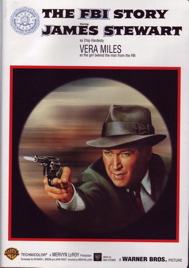
The FBI Story
1959 / 149 min. / 1:78 anamorphic enhanced / also available separately at 19.98
Starring James Stewart, Vera Miles, Murray Hamilton, Larry Pennell, Nick Adams, Diane Jergens, Jean Willes, Joyce Taylor
Cinematography Joseph Biroc
Art Direction John Beckman
Film Editor Philip W. Anderson
Original Music Max Steiner
Written by Richard L. Breen, John Twist from a book byDon Whitehead
Produced and Directed by Mervyn LeRoy
When people are asked to think of conservative 50's actors lending themselves to movies supporting "the establishment" they always come up with John Wayne. In reality, James Stewart was the real spokesman for right-wing America. Too classy to make a public show of his politics, Stewart was a Brigadier General in the U.S. Air Force Reserve. When not making cute comedies, Alfred Hitchcock classics or westerns with bedtime-story moral lessons (see Night Passage some time), Stewart often used his considerable skills as a motion picture pitchman for conservative corporate and government interests. Often these were just standard recruiting boosters. Strategic Air Command concerned a Monty Stratton- like big league player who opts for a life as a bomber pilot because it's more satisfying knowing he's on the front lines of America's defense. Perennial service wife June Allyson comes along for the ride, bringing her positive housewife vibes from The Stratton Story and The Glenn Miller Story.
Nobody's going to blame Stewart for doing his bit when the military needed recruiting help. Much more disturbing is the warped melodrama Thunder Bay, a tale of oil drilling in the Gulf of Mexico that patronizes fishermen and ecologists and belittles their 'silly superstition' that oil drilling might hurt the environment. And then there's the hateful The Mountain Road, a WW2 story that tells us that Chinese peasants are a subhuman mass incapable of appreciating Yankee attempts to help them. Stewart's men only want to stop the Japanese army by blowing up bridges, a plan that dooms untold numbers of civilians. Of course, Stewart's demolition expert finds consolation in the arms of an obliging Chinese beauty, Lisa Lu. The 1960 movie fairly represents America's fearful attitude to the Far East prior to Vietnam.
Stewart was a powerful force in moviemaking and could change any dialogue he didn't like. That makes some of his zingers very suspicious. His vengeful cowboy in The Man from Laramie stares at the camera and says without irony, "I know the U.S. Cavalry, and the U.S. Cavalry would never fire first at Indians." Uh-huh.
This brings us to The FBI Story, a fictionalized history that goes beyond honoring the Bureau to make some really painful distortions about J. Edgar Hoover's police establishment. Stewart is right there, turning a fictionalized über-agent into a kind of Father Knows Best meets G-Men, a square guy defending the interests of Freedom whether they be threatened by punk gangsters, political extremists or foreign agents. The overall message is that Freedom is being assaulted on all sides, and stop asking questions and let our secret investigation force do what it wants.
The FBI Story isn't a good movie, but it also isn't the worst offender of the "Commie Scare" 1950s films. It's just depressing hearing our hero James Stewart obviously quite convinced of the wisdom of his words when he tells us that Communists have infiltrated our society's most cherished institutions. The script's idea of a smart line is for Stewart's Agent Chip to conclude that his target, an "ordinary guy" (played by glaringly vile villain specialist Paul Genge) is a Communist and therefore won't be going to church on Sunday Morning. This is tossed off with other typical 50s racial slurs: Although the movie makes a big deal about defending Indian rights, the script goes in for plenty of cheap 'dumb Indian' humor.
The klunky screenplay tells the history of the Bureau through the career of Chip Hardesty, a 'swell guy' agent who fights for The American Way while going through lame family drama schtick at home. The family issues are petty -- he gripes that his son borrows his things while being supportive and sweet to his insecure daughter. Vera Miles is a rather moody alternative to June Allyson. In some of their close-ups we get the notion that Miles could have been just as glamorous as Kim Novak, had she been able to play the lead in the previous year's Vertigo. Alas, Lucy Hardesty is contrived only to bolster the rightness of Agent Chip's loyalty to the FBI. He lies to her, and she forgives him. She encourages him to follow his Bureau ambitions and then leaves him when Agents are being killed left and right. Lucy finally accepts her proper role, which is to make babies and leave everything else to her husband. The script gives them terrible, mealy-mouthed dialogue every time a real marital crisis develops. Agent Chip constantly substitutes sentimental phrases for real communication, the same way the film uses a beanie hat that plays "Yankee Doodle Dandy" to represent the unimpeachable rightness of Fighting Evil for J. Edgar Hoover. As Ray Walston would say in Damn Yankees, it's gauche.
The movie is pure propaganda for the Bureau and was obviously fine-tuned by J. Edgar himself. Except for one official-looking shot, Hoover appears only in silhouette or shadow, as if he's too sacred to be directly dramatized. The Bureau was just starting a decade of strong anti-Civil Rights activity, but is pictured as being the savior of the oppressed and downtrodden, the enemy of the Klan and the protector of poor ignorant Indians being cheated. Hoover built his department's reputation and budgetary success on manufactured publicity hunting down relatively easy criminal targets in the 1930s -- rural bandits who were often built up in the newspapers with colorful names so the Bureau would look good taking them down. The movie even shows Hoover personally arresting Alvin Karpis, which in reality must have been a publicity stunt manufactured to make J. Edgar seem like an honest-to-goodness Dick Tracy. Meanwhile, the real criminal threat to America, organized crime by connected hoods in the big cities, prospered relatively untouched.
The FBI's finest work was its anti-foreign spy operations in WW2, as honestly recounted in the DeRochemont film The House on 92nd Street. It happily reported that not one successful act of wartime sabotage occurred under the FBI's watch. The FBI Story instead gives us a silly episode in an "unnamed" Spanish-speaking South American country (that can only be Argentina) that's violating neutrality by aiding the Axis' illegal spies instead of our American illegal spies. A Juan Valdez-like moronic Latin stereotype dies saving his beloved gringos from capture by Federales, Gunga Din-style. The movie has high-ranking experienced lawyer Chip Hardesty going to (presumably) Buenos Aires to effect an agent recall mission that could have been handled by a coded radio message.
The FBI Story opens up with a wildly insulting story of how Bureau efficiency and technology catches a clod criminal (a perfectly cast Nick Adams) who blows up an airliner to collect a $37,000 life insurance policy. We're shown how the agents work like dogs amassing tons of evidence, but also encourage Adams' neighbors and relatives to inform on him. The agents naturally handle Adams with kid gloves, telling him he doesn't have to talk and offering to let him contact a lawyer. In an idiotic turn of events, the mass murderer practically hands his inquisitors a confession on a plate, negating the entire point of the sequence.
I've already stated my opinion of the final episode's insistence on the existence of an "International Communist Conspiracy" -- as opposed to documented Soviet spy rings operating in the U.S.. This thrilling finale consists of teams of agents following two unarmed but traitorous Reds around New York while Chip directs their movements from his desk, reporting every few minutes directly to J. Edgar Hoover. The two Commies bozos are jumped by a dozen agents when they try to exchange some damning microfilm in a bar. Agent Chip gets a verbal pat on the back from J. Edgar, which is supposed to be a momentous personal triumph. The funny part is that the two spies could have skipped all the skullduggery just by making use of our convenient and impersonal U.S. Mail service, a federal bureau that doesn't need to generate self-aggrandizing propaganda to stay in business.
Warners' DVD of The FBI Story appears to be a reissue of a previous release. It has no extras, only a hard-hitting trailer emphasizing James Stewart's role as a crime fighter. Interestingly, the film has Stewart lighting a cigar during the ambush of John Dillinger, an image central to John Milius' 1973 shoot-'em-up bio Dillinger, the story of top agent Melvin Purvis. In some aspects Stewart's Chip Hardesty is a cleaned-up version of Purvis, who reportedly became "too popular" for Hoover's cult of personality and retired from the force only a year later. Purvis' full story wouldn't fit the squeaky-clean FBI image, as he shot himself to death in 1960, with a gun given to him when he retired.
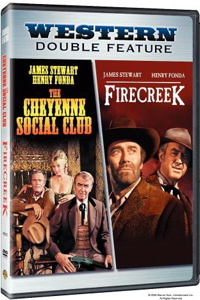
Firecreek
1968 / 104 min. / 2:40 anamorphic enhanced / available separately in a double bill with The Cheyenne Social Club for 19.98
Starring James Stewart, Henry Fonda, Inger Stevens, Gary Lockwood, Dean Jagger, Ed Begley, Jay C. Flippen, Jack Elam, James Best, BarBara Luna, Jacqueline Scott
Cinematography William H. Clothier
Art Direction Howard Hollander
Film Editor William Ziegler
Original Music Alfred Newman
Written by Calvin Clements
Produced by Philip Leacock, John Mantley
Directed by Vincent McEveety
Director Vincent McEveety is mostly known for Disney movies of the "Shook Up Shopping Cart" variety but got his start in television directing Rawhide and The Untouchables. One of his few non-Disney movies is this acceptable but undistinguished western from 1968, a somewhat bleak tale made just before Westerns turned bloody and downbeat under the influence of Sergio Leone and Sam Peckinpah. James Stewart is a rather uninteresting reluctant hero, but co-star Henry Fonda plays a black-bearded bad guy with a melancholy mean streak, a full year before he 'came out' as the ultimate villain in Leone's Once Upon a Time in the West.
Firecreek looks great on paper, with a top cast and a concentrated story. As a movie it has serious pacing problems and a definite problem with originality: Everything we see reminds us of older, better westerns, especially High Noon. It also works too hard to present an uninteresting conflict between the religious but morally lazy citizens of Firecreek and the utterly irredeemable Larkin bunch. Good acting shores up the drama, but it all seems like something we've seen before.
The good is definitely in the casting. Ed Begley is an annoying fire and brimstone preacher but good and underused actresses Inger Stevens, Jacqueline Scott (of Charley Varrick) and Louise Latham (Marnie) get a chance to show what they can do. Most of the other 'good' characters are limited to stares of defeat, while the flamboyant bad guys Jack Elam and especially Gary Lockwood do their best to keep things lively.
Young Brooke Bundy has a good role as a frisky girl who thinks that Lockwood has some style, even after he's threatened to rape her. Unfortunately, her character Leah is given little to do in the film's final act.
Firecreek was noted as a tough and grim western at a time when people really wanted to see something like Butch Cassidy and the Sundance Kid. James Stewart's family audiences didn't cotton to near-rape scenes, a grisly hanging and the bitter face-off between fave actors Stewart and Henry Fonda. It all seems too much of an excuse to get Stewart back into his "Anthony Mann" physical torment schtick, stumbling around the dusty street with a bullet in his leg and making frantic speeches about the morality of the territorial imperative. When the good shoot-out action finally comes, it's long overdue. The movie is watchable but nothing all that memorable. Henry Fonda comes out with his dignity barely intact.
Warners' DVD of Firecreek is a beautiful Panavision enhanced transfer with excellent sound for Alfred Newman's score. I'd only seen the movie on a drive-in screen and didn't know it looked this good. The film shares a flipper disc with The Cheyenne Social Club, and has no special extras.

The Cheyenne Social Club
1970 / 103 min. / 2:40 anamorphic enhanced /available separately in a double bill with Firecreek for 19.98
Starring James Stewart, Henry Fonda, Shirley Jones, Sue Ane Langdon, Elaine Devry, Robert Middleton
Cinematography William H. Clothier
Production Design Gene Allen
Film Editor Adrienne Fazan
Original Music Walter Scharf
Written by James Lee Barrett
Produced and Directed by Gene Kelly
The Cheyenne Social Club is considered somewhat of a disaster but it's really an okay picture that struggles with problems of taste and judgment. Henry Fonda had played with naughtiness in the amusing The Rounders years before, but he and Stewart weren't willing to be in films with truly dangerous non-family content (good example: McCabe & Mrs. Miller) and instead opted for a strange compromise. There's something essentially tasteless about cozying up to a topic that really needs an "R" or an "X" rating, and then acting as if it's all innocent fun. The movie is perhaps former dance genius Gene Kelly's best post-MGM directing effort, but it still pretty much marked the end of his career behind the camera.
Stewart, Fonda, and Gene Kelly surely meant to bend with the times -- permissiveness, "X" rated movies -- but really succeeded only in confusing their core audience. The Cheyenne Social Club never uses the words prostitution or whore. It maintains a slightly sticky cuteness throughout that almost works, until we realize that its conception of a bawdy house is a filigreed fantasy for dirty old men. The women are gorgeous and pliable, everybody's healthy and happy and we don't see any business being conducted. We only hear bells ring that summon the four 'girls' off screen to their next customer. The movie is almost clean enough for the days of the old Production Code, except for Stewart's coy "aw shucks" double takes at allusions to sexual activity, and Henry Fonda's frequent knowing grins.
Both characters do visit their 'girls', but only in a non-professional sense when "it" is given away out of pure generosity; the girls are better than a fantasy out of Playboy magazine. Constant sex with strangers is apparently just a (sigh) happy lifestyle choice. It's an oddly sanitized mix, when theaters were showing movies like The Best House in London and the much sleazier family film Paint Your Wagon. No wonder that 1970 audiences were confused.
The movie is rated PG but you wouldn't know it from Stewart's visit with Pauline (Elaine Devry, who already made her erotic mark in Gene Kelly's previous - and far smuttier - sex comedy A Guide for the Married Man). This may be news to viewers who saw the film on television, but for a game of patty-cake with "Mr. G-Rated" Stewart the actress is essentially topless under a sheer nightgown. The effect is spectacular.
While recovering from that scene, we note that besides featuring Miss Jones as Stewart's main sweetie, the film gives special attention to Sue Ane Langdon (who previously frolicked with Fonda in The Rounders). The other girls have smaller bits, which is a shame because Annie Jo is played by the delightful Jackie Joseph of the original Little Shop of Horrors and several Joe Dante comedies. She's both sexy and funny and it's a shame we don't get to hear more of her wonderful voice.
In terms of production, direction and acting The Cheyenne Social Club is not bad at all. Stewart and Fonda are consistently amusing and their rapidly changing fortunes in Cheyenne make for some good action climaxes. Favorite baddie Robert J. Wilke loses a gunfight to Stewart by virtue of a fluke accident, with the result that Stewart has to face a whole bunch of onerous relations out to gun him down. Fonda knows that since neither of them is a decent shot, it's a good time to cut and run. Stewart, having developed a paternal (or pimp-ternal) attachment to his girls, stays to fight alone. The finale is nicely worked out.
The cast has meaty roles for Ray Middleton, Dabbs Greer, Jean Willes and J. Pat O'Malley, who peddles a patented "health" elixir that has turned a 111 year-old codger into a somnambulistic zombie.
Warner's DVD of this original National General release is a beautiful enhanced Panavsion transfer; the movie looks much better than the pan-scanned (and I presume slightly censored) TV prints that ran for years. A fairly lame contemporary promo piece has Fonda and Stewart singing (sort of) a song for the film; the trailer is smartly designed.
On a scale of Excellent, Good, Fair, and Poor,
|
The Stratton Story rates:
Movie: Excellent Video: Excellent Sound: Excellent Supplements: Trailer, short Pest Control, cartoon Batty Baseball, Radio show with Stewart and Allyson, Millard Mitchell |
The Naked Spur rates:
Movie: Excellent Video: Good Sound: Very Good Supplements: Trailer, short Things We Can Do Without, cartoon Little Johnny Jet |
|
The Spirit of St. Louis rates:
Movie: Excellent Video: Excellent Sound: Excellent Supplements: Trailer, Premiere newsreel, comedy short So Your Wife Wants to Work, cartoon Tabasco Road |
The FBI Story rates:
Movie: Good / Fair Video: Very Good Sound: Excellent Supplements: Trailer |
|
Firecreek rates:
Movie: Good- Video: Excellent Sound: Excellent Supplements: Trailer |
The Cheyenne Social Club rates:
Movie: Good Video: Excellent Sound: Excellent Supplements: Trailer, Good Time Girls featurette |
Reviewed: August 8, 2006
|
|
Reviews on the Savant main site have additional credits information and are more likely to be updated and annotated with reader input.
Review Staff | About DVD Talk | Newsletter Subscribe | Join DVD Talk Forum
Copyright © DVDTalk.com All rights reserved | Privacy Policy | Terms of Use
|
| Release List | Reviews | Price Search | Shop | SUBSCRIBE | Forum | DVD Giveaways | Blu-Ray/ HD DVD | Advertise |





